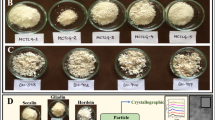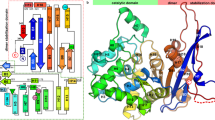Abstract
ELECTROPHORESIS of albumins of mature seeds of Vicia faba on polyacrylamide gel, with subsequent location of L-glutamic acid dehydrogenase (L-glutamate: NAD oxidoreductase (deaminating) EC 1.4.1.2) (GDH), using a tetrazolium procedure, revealed that this enzyme could be separated into a number of isoenzymes. A preliminary investigation has been made of these isoenzymes together with an examination of their distribution within the seeds and seedlings of Vicia faba (broad bean) and Pisum sativum (pea).
This is a preview of subscription content, access via your institution
Access options
Subscribe to this journal
Receive 51 print issues and online access
$199.00 per year
only $3.90 per issue
Buy this article
- Purchase on Springer Link
- Instant access to full article PDF
Prices may be subject to local taxes which are calculated during checkout
Similar content being viewed by others
References
Orstein, L., and Davis, B. J., Disc Electrophoresis (Preprint by Distillation Products Industries (Eastman Kodak Co.), Rochester, New York, 1961).
Fox, D. J., Thurman, D. A., and Boulter, D., Phytochem., 3, 417 (1964).
Laycock, M. V., Thurman, D. A., and Boulter, D., Clinica Chim. Acta, 11, 98 (1965).
Bulen, W. A., Arch. Biochem. Biophys., 62, 173 (1956).
Author information
Authors and Affiliations
Rights and permissions
About this article
Cite this article
THURMAN, D., PALIN, C. & LAYCOCK, M. Isoenzymatic Nature of L-Glutamic Dehydrogenase of Higher Plants. Nature 207, 193–194 (1965). https://doi.org/10.1038/207193a0
Issue Date:
DOI: https://doi.org/10.1038/207193a0
This article is cited by
-
Biosystematic studies onCapsella bursa-pastoris (Brassicaceae): Enzyme polymorphism in natural populations
Plant Systematics and Evolution (1981)
-
Glutamate dehydrogenase from Pisum sativum L.
Planta (1980)
-
Electrophoresis of human L-glutamate dehydrogenase: Tissue distribution and preliminary population survey
Biochemical Genetics (1977)
-
�ber den Reaktionsmechanismus pflanzlicher Glutamatdehydrogenase und die Regulation der Aktivit�t durch Adenosinphosphate, die Energieladung und Ionen
Planta (1975)
-
Glutamate dehydrogenase
Journal of Bioenergetics (1974)
Comments
By submitting a comment you agree to abide by our Terms and Community Guidelines. If you find something abusive or that does not comply with our terms or guidelines please flag it as inappropriate.



